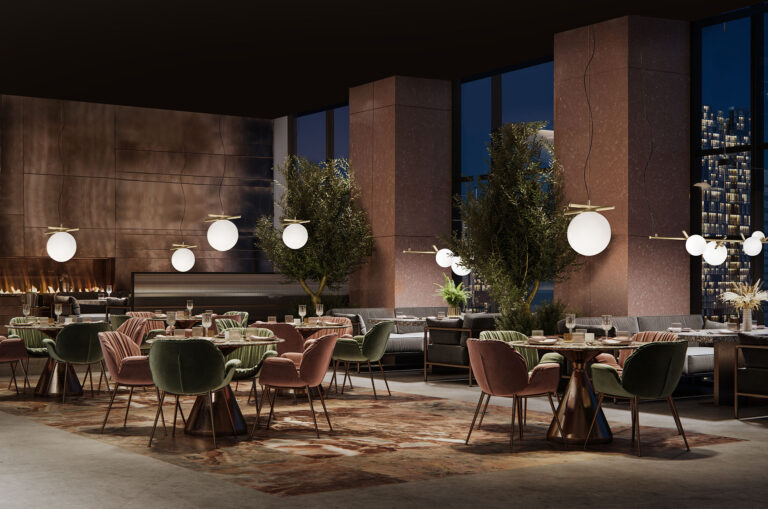In the world of dining, the ambiance is a language in itself. It conveys the mood, sets the stage, and transforms a mere meal into an immersive experience. One of the most crucial elements that influence this ambiance is lighting. The right lighting in restaurant design is more than just functional; it’s an art form that can profoundly impact how diners perceive and enjoy their culinary journey. Join us as we explore the language of lighting and its role in creating memorable restaurant ambiance.
1. Setting the Mood
Lighting is, first and foremost, a mood setter. When you walk into a restaurant, the type of lighting you encounter immediately informs you about the atmosphere. Soft, warm lighting creates a cozy and intimate mood, ideal for romantic dinners. In contrast, bright, vibrant lighting sets a lively and energetic tone, perfect for brunch or casual lunches.
Restaurants often adjust their lighting throughout the day to adapt to different dining experiences. The transition from a soft, dimly lit ambiance during dinner to a more well-lit, cheerful environment for lunch is a clear demonstration of the role of lighting in mood setting.
2. Focal Points and Visual Impact
Lighting is also a powerful tool to draw attention to specific areas within a restaurant. Well-placed fixtures can illuminate artwork, architectural features, or even the presentation of food, creating focal points that enhance the overall aesthetic. Lighting can serve as a visual storyteller, guiding diners’ eyes to key elements of the design.
In high-end restaurants, dramatic lighting can be used to highlight the presentation of dishes, making the culinary creations even more visually appealing. The interplay between cuisine and lighting is an art in itself, creating a captivating visual experience for diners.
3. Creating Ambience through Shadows and Glows
The play of shadows and glows is an essential element in restaurant lighting design. Well-thought-out shadows can add depth and dimension to the space, making it visually engaging. Shadows can also contribute to the overall feeling of intimacy, especially in upscale and romantic settings.
On the other hand, gentle glows can create warmth and comfort. Candles on tables, pendant lights, or wall sconces can cast a soft, inviting radiance that makes diners feel at ease and relaxed.
4. Enhancing Aesthetics
Lighting is a key component of the restaurant’s overall aesthetics. The choice of lighting fixtures and their design can reflect the restaurant’s theme and style. For example, contemporary fixtures with clean lines and minimalistic design can create a modern and sleek ambiance. In contrast, rustic or vintage fixtures can give a restaurant a charming, old-world feel.
Lighting also plays a crucial role in showcasing the decor and interior design. Carefully positioned lights can emphasize architectural elements, textures, and artwork, adding layers of visual interest to the space.
5. Practicality and Functionality
While ambiance is essential, practicality and functionality also come into play. Good lighting is necessary for diners to read menus and see their food clearly. The type of lighting used over tables can significantly affect diners’ comfort and overall experience. Adjustable lighting or multiple sources of light can cater to the varying needs of diners during different times of the day.
6. Thematic Lighting
In theme-based restaurants, lighting is often used to immerse diners in a specific atmosphere. For example, a restaurant with a nautical theme may incorporate marine-inspired fixtures and blue-toned lighting to create a sense of being underwater. A Thai restaurant might use warm, ambient lighting to evoke the feeling of a cozy, tropical evening. Thematic lighting adds an extra layer of storytelling to the dining experience.
7. Seasonal and Holiday Changes
Some restaurants change their lighting to coincide with seasons or holidays. Festive lighting during the holiday season can add an extra layer of cheer to the dining experience. Soft, warm lighting during the fall and winter can make diners feel cozy and comfortable, while brighter, cool-toned lighting in the spring and summer can create a fresh and inviting atmosphere.
8. Sustainable and Eco-Friendly Lighting
With growing environmental consciousness, many restaurants are incorporating sustainable and energy-efficient lighting solutions. LED lighting, for example, not only saves energy but also offers flexibility in color and intensity, allowing restaurants to create various atmospheres while being eco-friendly.
In Conclusion: The Art of Illumination
The role of lighting in restaurant design is multifaceted and often underestimated. Lighting is not merely about visibility; it’s about creating an immersive dining experience. It sets the mood, highlights visual elements, adds to the aesthetics, and tells a story. The next time you dine out, take a moment to appreciate the art of lighting, for it’s the unseen artist that shapes the ambiance and elevates your culinary journey. Explorex Restaurant Os is a great fit for all types of restaurants.

